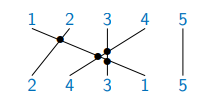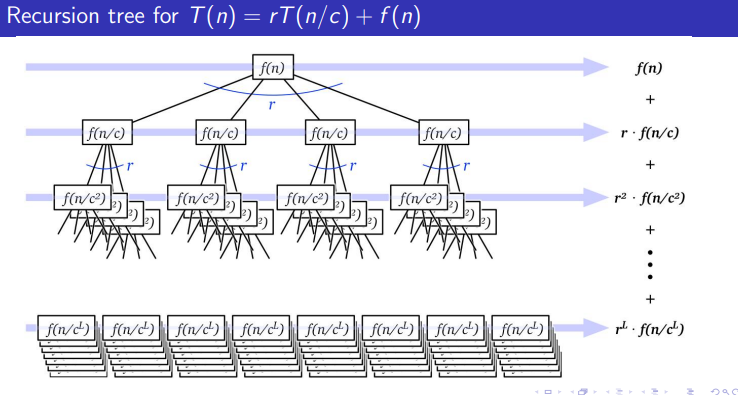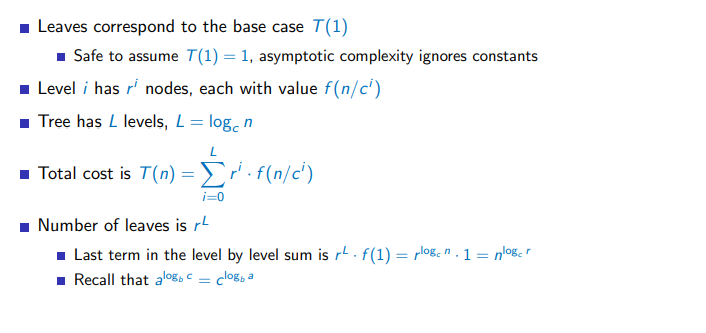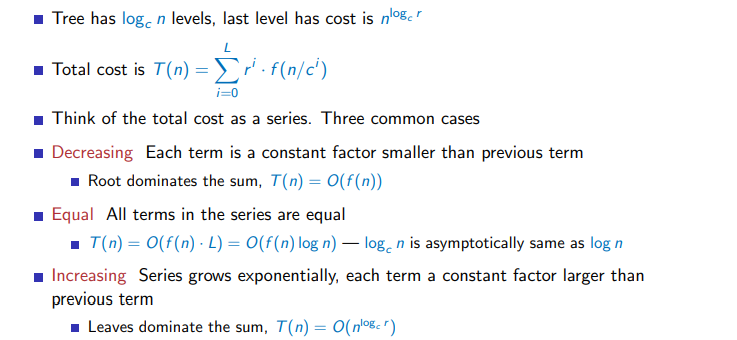Divide and conquer
Break up a problem into disjoint subproblems
Combine these subproblem solutions efficiently
Examples
Merge sort
- Split into left and right half and sort each half separately
- Merge the sorted halves
Quicksort
- Rearrange into lower and upper partitions, sort each partition separately
- Place pivot between sorted lower and upper partitions
Divide and conquer example
Counting inversions
Compare your profile with other customers
Identify people who share your likes and dislikes
No inversions – rankings identical
Every pair inverted – maximally dissimilar
Number of inversions ranges from 0 to n(n – 1) / 2

An inversion is a pair (i, j), i < j, where j appears before i
Recurrence:
Implementation
def mergeAndCount(A,B):
(m,n) = (len(A),len(B))
(C,i,j,k,count) = ([],0,0,0,0)
while k < m+n:
if i == m:
C.append(B[j])
j += 1
k += 1
elif j == n:
C.append(A[i])
i += 1
k += 1
elif A[i] < B[j]:
C.append(A[i])
i += 1
k += 1
else:
C.append(B[j])
j += 1
k += 1
count += m-i
return(C,count)
def inversionCount(A):
n = len(A)
if n <= 1:
return(A,0)
(L,countL) = inversionCount(A[:n//2])
(R,countR) = inversionCount(A[n//2:])
(B,countB) = mergeAndCount(L,R)
return(B,countL + countR + countB)
L = [2,4,3,1,5]
print(inversionCount(L)[1])
Output
4 # 4 is the number of inversions
Closest pair of points
Several objects on screen
Basic step: find closest pair of objects
objects — naive algorithm is - For each pair of objects, compute their distance
- Report minimum distance across all pairs
There is a clever algorithm that takes time
using divide and conquer Given n points
find the closest pair - Assume no two points have same
or coordinate - Split the points into two halves by vertical line
- Recursively compute closest pair in each half
- Compare shortest distance in each half to shortest distance across the dividing line
- Assume no two points have same
Recurrence:
Overall:
Pseudocode
def ClosestPair(Px,Py):
if len(Px) <= 3:
compute pairwise distances
return closest pair and distance
Construct (Qx,Qy), (Rx,Ry)
(q1,q2,dQ) = ClosestPair(Qx,Qy)
(r1,r2,dR) = ClosestPair(Rx,Ry)
Construct Sy from Qy,Ry
Scan Sy, find (s1,s2,dS)
return (q1,q2,dQ), (r1,r2,QR), (s1,s2,dS)
#depending on which of dQ, dR, dS is minimum
Implementation
import math
# Returns eucledian disatnce between points p and q
def distance(p, q):
return math.sqrt(math.pow(p[0] - q[0],2) + math.pow(p[1] - q[1],2))
def minDistanceRec(Px, Py):
s = len(Px)
# Given number of points cannot be less than 2.
# If only 2 or 3 points are left return the minimum distance accordingly.
if (s == 2):
return distance(Px[0],Px[1])
elif (s == 3):
return min(distance(Px[0],Px[1]), distance(Px[1],Px[2]), distance(Px[2],Px[0]))
# For more than 3 points divide the poitns by point around median of x coordinates
m = s//2
Qx = Px[:m]
Rx = Px[m:]
xR = Rx[0][0] # minimum x value in Rx
# Construct Qy and Ry in O(n) rather from Py
Qy=[]
Ry=[]
for p in Py:
if(p[0] < xR):
Qy.append(p)
else:
Ry.append(p)
# Extract Sy using delta
delta = min(minDistanceRec(Qx, Qy), minDistanceRec(Rx, Ry))
Sy = []
for p in Py:
if abs(p[0]-xR) <= delta:
Sy.append(p)
#print(xR,delta,Sy)
sizeS = len(Sy)
if sizeS > 1:
minS = distance(Sy[0], Sy[1])
for i in range(1, sizeS-1):
for j in range(i, min(i+15, sizeS-1)):
minS = min(minS, distance(Sy[i], Sy[j+1]))
return min(delta, minS)
else:
return delta
def minDistance(Points):
Px = sorted(Points)
Py = Points
Py.sort(key=lambda x: x[-1])
#print(Px,Py)
return round(minDistanceRec(Px, Py), 2)
pts = [(2, 15), (40, 5), (20, 1), (21, 14), (1,4), (3, 11)]
result = minDistance(pts)
print(result)
Output
4.12
Integer multiplication
- Traditional method:
- Naïve divide and conquer strategy:
- Karatsuba’s algorithm:
Implementation
# here 10 represent base of input numbers x and y
def Fast_Multiply(x,y,n):
if n == 1:
return x * y
else:
m = n/2
xh = x//10**m
xl = x % (10**m)
yh = y//10**m
yl = y % (10**m)
a = xh + xl
b = yh + yl
p = Fast_Multiply(xh, yh, m)
q = Fast_Multiply(xl, yl, m)
r = Fast_Multiply(a, b, m)
return p*(10**n) + (r - q - p) * (10**(n/2)) + q
print(Fast_Multiply(3456,8902,4))
Output
30765312.0
Quick select and Fast select
- Find the
smallest value in a sequence of length - Sort in descending order and look at position
- For any fixed
, find maximum for times – (median) – - Median of medians –
- Selection becomes
in Fast select algorithm - Quicksort becomes
using MoM
Implementation
def quickselect(L,l,r,k): # k-th smallest in L[l:r]
if (k < 1) or (k > r-l):
return(None)
(pivot,lower,upper) = (L[l],l+1,l+1)
for i in range(l+1,r):
if L[i] > pivot: # Extend upper segment
upper = upper + 1
else: # Exchange L[i] with start of upper segment
(L[i], L[lower]) = (L[lower], L[i])
(lower,upper) = (lower+1,upper+1)
(L[l],L[lower-1]) = (L[lower-1],L[l]) # Move pivot
lower = lower - 1
# Recursive calls
lowerlen = lower - l
if k <= lowerlen:
return(quickselect(L,l,lower,k))
elif k == (lowerlen + 1):
return(L[lower])
else:
return(quickselect(L,lower+1,r,k-(lowerlen+1)))
print(quickselect([5,3,7,2,1],0,5,2))
Output
2
Median of Medians(MoM)
Divide L into blocks of 5
Find the median of each block (brute force)
Let M be the list of block medians
Recursively apply the process to M
We can visualize the blocks as follows

Each block of 5 is arranged in ascending order, top to bottom
Block medians are the middle row
The median of block medians lies between 3len(L)/10 and 7len(L)/10

Implementation
def MoM(L): # Median of medians
if len(L) <= 5:
L.sort()
return(L[len(L)//2])
# Construct list of block medians
M = []
for i in range(0,len(L),5):
X = L[i:i+5]
X.sort()
M.append(X[len(X)//2])
return(MoM(M))
print(MoM([4,3,5,6,2,1,8,9,7,10,13,15,18,17,11]))
Output
8
Fast select using MOM
Implementation
def MoM(L): # Median of medians
if len(L) <= 5:
L.sort()
return(L[len(L)//2])
# Construct list of block medians
M = []
for i in range(0,len(L),5):
X = L[i:i+5]
X.sort()
M.append(X[len(X)//2])
return(MoM(M))
def fastselect(L,l,r,k): # k-th smallest in L[l:r]
if (k < 1) or (k > r-l):
return(None)
# Find MoM pivot and move to L[l]
pivot = MoM(L[l:r])
pivotpos = min([i for i in range(l,r) if L[i] == pivot])
(L[l],L[pivotpos]) = (L[pivotpos],L[l])
(pivot,lower,upper) = (L[l],l+1,l+1)
for i in range(l+1,r):
if L[i] > pivot: # Extend upper segment
upper = upper + 1
else: # Exchange L[i] with start of upper segment
(L[i], L[lower]) = (L[lower], L[i])
(lower,upper) = (lower+1,upper+1)
(L[l],L[lower-1]) = (L[lower-1],L[l]) # Move pivot
lower = lower - 1
# Recursive calls
lowerlen = lower - l
if k <= lowerlen:
return(fastselect(L,l,lower,k))
elif k == (lowerlen + 1):
return(L[lower])
else:
return(fastselect(L,lower+1,r,k-(lowerlen+1)))
print(fastselect([4,3,5,6,2,1,8,9,7,10,13,15,18,17,11],0,15,4))
Output
4
Recursion trees
Recursion tree-Rooted tree with one node for each recursive subproblem
Value of each node is time spent on that subproblem excluding recursive calls
Concretely, on an input of size
is the time spent on non-recursive work is the number of recursive calls - Each recursive call works on a subproblem of size
Resulting recurrence:
Root of recursion tree for
has value Root has
children, each (recursively) the root of a tree for Each node at level
has value - Assume, for simplicity, that
was a power of
- Assume, for simplicity, that


